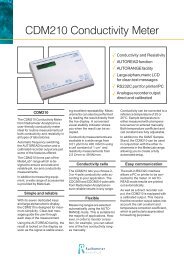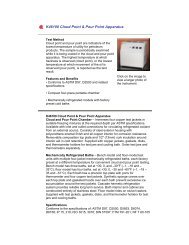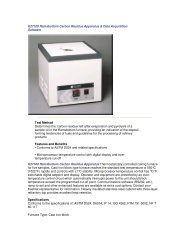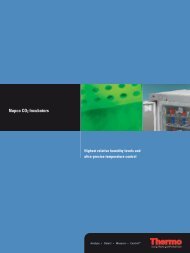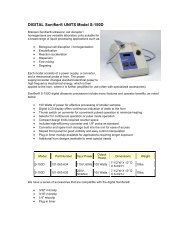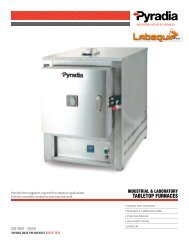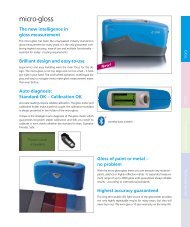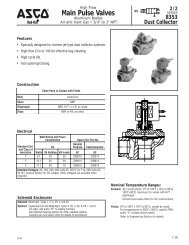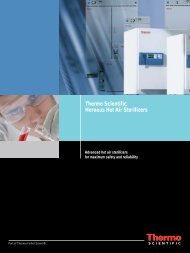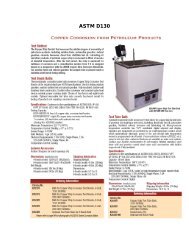GC Catalog.pmd - Labequip
GC Catalog.pmd - Labequip
GC Catalog.pmd - Labequip
- No tags were found...
Create successful ePaper yourself
Turn your PDF publications into a flip-book with our unique Google optimized e-Paper software.
DetectorsThere are Nine (9) specific detectors available for the Buck 910- and 310-series <strong>GC</strong> systems. The larger 910-<strong>GC</strong>can accommodate up to FOUR (4) of these assorted detectors, either in series (from non-destructive to destructive)or in parallel (using a split stream), although there are a few limited combinations that are not feasible because ofspace conflicts. Detector types are selected by the User, depending on the application. All detectors must befactory installed.Detectors1) TCD (Thermal Conductivity Detector) A “universal” detector able to measure almost ALL molecules; inorganic andpermanent gases as well as organic vapors. Operates below 275 o C, and gives a typical DL of ~250PPM, with linearity to~100% for most species. A good nondestructive detector for general Organic and Analytical testing, it is also used forCombustion Gas and Stack Gas testing, Atmospheric monitoring, and bulk measurements. Helium is the recommended carrier.2) FID (Flame Ionization Detector) Commonly used for Organic analyses, it is specific for Hydrocarbon species with aworking range from ~10PPM to 10% for C1-C10 compounds. It has a high temperature range, over 400 o C, and can beinterfaced with add-on detectors for selective-species measurements. Solvent and material characterization, environmentalsamples, TPH and petroleum analyses are primary applications. Air & Hydrogen are support gases, using Helium for a carriergas.3) DELCD (Dry Electro-Lytic Conductivity Detector) This detector, with FID, is ideal for environmental applications whereHalogenated Hydrocarbons and Pesticides can be easily differentiated from Solvent matrix backgrounds. Cleaner and morelinear response of DELCD compared to ECD still gives sensitivities in the 10PPB range; and meets most EPA specifications forthe 600- and 8000-series methods. Works best using Helium for a carrier, with Air & Hydrogen as supplemental gases.4) HID (Helium Ionization Detector) Provides “universal” detection; and is non-destructive, similar to TCD; for gaseousspecies with an Ionization Potential below that of Helium. Less expensive than similar detectors; it provides DLs of ~1-10PPMfor most gases. Suited for special tests; such as Transformer Oil Gases, Road Bed Emissions and other non-Organic vapormeasurement. High-quality Helium is required as Carrier.5) NPD (Nitrogen Phosphorus Detector) Designed for Agricultural and Drug testing, this modified Thermionic Bead Detectorresponds to Nitrogen-bearing compounds to concentrations of ~100PPB or lower; with Phosphorus-containing materialsdetectable at ~500PPB. As part of an FID assembly, it needs the Air-Hydrogen jet to burn the eluting “peak” with a Heliumcarrier.6) ECD (Electron Capture Detector) Originally designed for single PPB level detection of Chlorinated organic compounds, itrequires a special carrier gas of Argon-Methane and low-bleed columns for optimal results Still the most sensitive detectoravailable for the environmental monitoring of Halocarbons and Pesticides, with 1-5PPB detection limits. Usually run independentof other detectors.7) PID (Photo-Ionization Detector) A high-intensity “UV” source, the 10.6eV Krypton Lamp generates powerful energy to“excite” UNSATURATED organic; such as Aromatics, Olefins, Ketones and Esters. The low 10-50PPB DLs for the Aromaticcompounds make it ideal for environmental testing for BTEX, PAH and PNA species. Non-destructive measurements make itideal for use with an FID/combo detector.8) FPD (Flame Photometric Detector) Employs either a single- or double-phototube detector that “sees” the light from burningSulfur or / and Phosphorus compounds. Crucial for Stack and Combustion Gas testing,Natural Gas, refined Hydrocarbons andeven Pesticide materials. Superior detection limits in the 1-10PPB range are achieved with advance electronics and proprietaryoptical designs. Uses a rich Hydrogen flame, often used in conjunction with FID and with a Helium carrier gas.9) CCD (Catalytic Combustion Detector) A unique and economical alternative to the FID for the detection of hydrocarboncompounds has a typical detection limit of about 500 ppm when run with a helium carrier. The CCD can also run at lowertemperatures (



